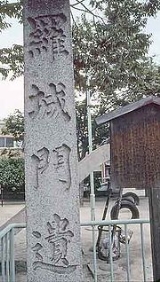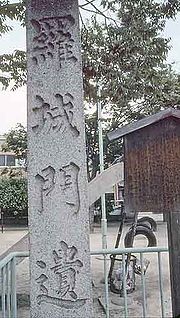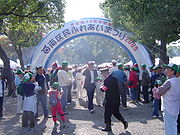
Minami-ku, Kyoto
Encyclopedia

Wards of Kyoto
The city of Kyoto in Kyoto Prefecture, Japan has eleven wards.Unlike the 23 special wards of Tokyo, the wards of Kyoto are not separate municipalities, they are divisions just for municipal administration. Together, they comprise the city of Kyoto, under a single mayor and city council....
in the city
Municipalities of Japan
Japan has three levels of government: national, prefectural, and municipal. The nation is divided into 47 prefectures. Each prefecture consists of numerous municipalities. There are four types of municipalities in Japan: cities, towns, villages and special wards...
of Kyoto, in Kyoto Prefecture
Kyoto Prefecture
is a prefecture of Japan located in the Kansai region of the island of Honshu. The capital is the city of Kyoto.- History :Until the Meiji Restoration, the area of Kyoto prefecture was known as Yamashiro....
, Japan. Its name means "South Ward." It was established in 1955 when it was separated from Shimogyo-ku. As of April, 2008 the ward has an estimated population of 98,320 people. The Kamo River and the Katsura River
Katsura River
The is a continuation of two other rivers, the Hozu River, a small, speedy river which begins in the mountains near Kameoka and then slithers through the mountains separating Kameoka and Kyoto; and the Ōi River , which emerges from those mountains and expands into a shallow, slow-flowing river...
flow through the district. It is home to several historical places and temples.
Minami-ku is roughly bound on the east by the Kamo River
Kamo River
The is located in Kyoto Prefecture, Japan. The riverbanks are popular walking spots for residents and tourists. In summer, restaurants open balconies looking out to the river. There are pathways running alongside the river on which one can walk along the river, and some stepping stones that cross...
, on the west by the Katsura River
Katsura River
The is a continuation of two other rivers, the Hozu River, a small, speedy river which begins in the mountains near Kameoka and then slithers through the mountains separating Kameoka and Kyoto; and the Ōi River , which emerges from those mountains and expands into a shallow, slow-flowing river...
(although it extends over the Katsura River in some places), on the north by Hachijō Street and the JR Kyoto line (leading into Kyoto station), and on the south by the Meishin Expressway
Meishin Expressway
The is a toll expressway in Japan. It runs from a junction with the Tomei Expressway in Nagakute, Aichi west to Nishinomiya, Hyōgo . It is the main road link between Osaka and Nagoya, and, along with the Tōmei Expressway, forms the main road link between Osaka and Tokyo...
(although it extends over the expressway in some places).
The southern portion of Kyoto city (including Minami-ku) is sometimes referred to as Rakunan. This area is the only side of Kyoto not lined with mountains, a feature that historically made Rakunan important as a gateway into Kyoto.
Minami-ku is more working-class than some other Kyoto districts, and includes a large population of Korean nationals known as Zainichi Koreans. Instead of restaurants and clubs, portions of the land near the Kamo River are lined with factories and industrial buildings. Residential areas include both standard houses and apartments, and occasional government-subsidized housing projects.
The area around Kujo Street from around Toji station to the Kamo River is known as Higashi (east) Kujo. This area is particularly working-class, and home to a relatively large number of Korean nationals and other working class members of Japanese society. As such, it has been called "Kyoto's only international town".
Minami-ku has few notable areas of tourist interest compared to other parts of Kyoto. A notable exception is the To-ji Temple.
The Minami-ku ward office is located on Route 1, near its intersection with Kujō Street. The Kyoto City Disaster Prevention Center is also in Minami-ku, near the intersection of Route 1 and Jujō Street. The home office of international company Nintendo
Nintendo
is a multinational corporation located in Kyoto, Japan. Founded on September 23, 1889 by Fusajiro Yamauchi, it produced handmade hanafuda cards. By 1963, the company had tried several small niche businesses, such as a cab company and a love hotel....
is also near that intersection.
To the east of Minami-ku is Higashiyama-ku
Higashiyama-ku, Kyoto
' is one of the eleven wards in the city of Kyoto, in Kyoto Prefecture, Japan. It was created in 1929 when it was split off from Shimogyō-ku. During the years 1931 to 1976 it also covered the area of present-day Yamashina-ku, which was an independent town until its merger into the city in 1931...
, and to the southeast is Fushimi-ku
Fushimi-ku, Kyoto
is one of the eleven wards in the city of Kyoto, in Kyoto Prefecture, Japan. Famous places in Fushimi include the Fushimi Inari Shrine, with thousands of torii lining the paths up and down a mountain; Fushimi Castle, originally built by Toyotomi Hideyoshi, with its rebuilt towers and gold-lined...
.

Temples and Landmarks
- Former site of the Rashomon GateRashomon Gatewas the gate built at the southern end of the monumental Suzaku Avenue in the ancient Japanese cities of Heijō-kyō and Heian-kyō , in accordance with the Chinese grid-patterned city layout. At the other far north-end of Suzaku Avenue, one would reach the Suzakumon Gate, the main entrance to the...
, the old Southern entrance to the city - Tō-jiTo-jiis a Buddhist temple of the Shingon sect in Kyoto, Japan. Its name means East Temple, and it once had a partner, Sai-ji . They stood alongside the Rashomon, the gate to the Heian capital. It is formally known as which indicates that it previously functioned as a temple providing protection for the...
a famous Buddhist temple with strong associations to the Buddhist priest KūkaiKukaiKūkai , also known posthumously as , 774–835, was a Japanese monk, civil servant, scholar, poet, and artist, founder of the Shingon or "True Word" school of Buddhism. Shingon followers usually refer to him by the honorific titles of and ....

